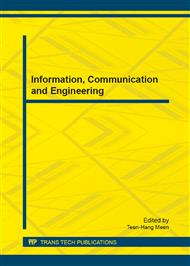[1]
Milgram P., Kishino F. (1994) A Taxonomy of Mixed Reality Visual Displays, IEICE Transactions on Information Systems:1321-1329.
Google Scholar
[2]
Sutherland, I. E. (1968). A head-mounted three dimensional display. Proceedings of AFIPS Conference, vol. 33 (pp.756-764). Washington, D.C.: Thompson Books.
Google Scholar
[3]
Rung-Tai Lin, The design of cultural and creative design of value-added art appreciation (2005)
Google Scholar
[4]
Kuang Yu Huang and Chuen-Jiuan Jane, A Hybrid Model for Stock Market Forecasting and Portfolio Selection Based on ARX, Grey System and RS Theories. Expert Systems With Applications, 36 (2009) 5387-5392.
DOI: 10.1016/j.eswa.2008.06.103
Google Scholar
[5]
Kuang-Yu Huang, A Hybrid GRA / MV Model for the Automatic Selection of Investment Portfolios with Minimum Risk and Maximum Return. The Journal of Grey System, 21-2(2009) 149-166.
Google Scholar
[6]
Julong. D (1989), "Introduction to Grey System Theory", Journal of Grey System, 1-24.
Google Scholar
[7]
Kayacan. E., Kaynak. O. and B. Ulutas (2010). "Grey System Theory- Based models in time Series prediction", Expert Systems with Application37, 1784-1789.
DOI: 10.1016/j.eswa.2009.07.064
Google Scholar
[8]
Lin. Y. H., Lee. P. Ch and T. P. Chang (2009), "Adoptive and high- precision grey forecasting model", ELSEVIER, 9658-9662.
Google Scholar
[9]
Lu, M (2007). "Analysis and Forecast of Road Traffic Safety Improvement in Netherlands", ARS Traffic & Transport Technology, 1-14.
Google Scholar
[10]
Tongyuan. H. and W. Yue (2007)," Forecasting Model Of Urban Traffic Accidents Based on Grey Model-GM (1, 1)", Institute of Computer, Chongqing Institute of Technology, 438-441.
DOI: 10.1109/dmamh.2007.81
Google Scholar
[11]
Wu. W. Y and Sh. P. Chen (2005), " A Prediction method Using the Grey Model GMc(1,n) Combined With the Grey Relational Analysis: a case study on internet access population forecast", ELSEVIER, 198-217.
DOI: 10.1016/j.amc.2004.10.087
Google Scholar
[12]
Zhan Li. M and S. Jin-Hua (2011), "Application of Grey- Markov Model in Forecasting Fire Accidents", Precedia Engineering11, 314-318.
DOI: 10.1016/j.proeng.2011.04.663
Google Scholar
[13]
Zhou. P., Ang. B.W and K. L. Poh (2006), "A trigonometric Grey Prediction Approach to Forecasting Electricity Demand", Energy Conversion & Management31, 2839-2847.
DOI: 10.1016/j.energy.2005.12.002
Google Scholar
[14]
Zhu. X (2010), "Application of Composite Grey BP Neural Network Forecasting Model to Motor Vehicle Fatality Risk", Second International Conference on Computer Modeling and Simulation, 236-240.
DOI: 10.1109/iccms.2010.257
Google Scholar


